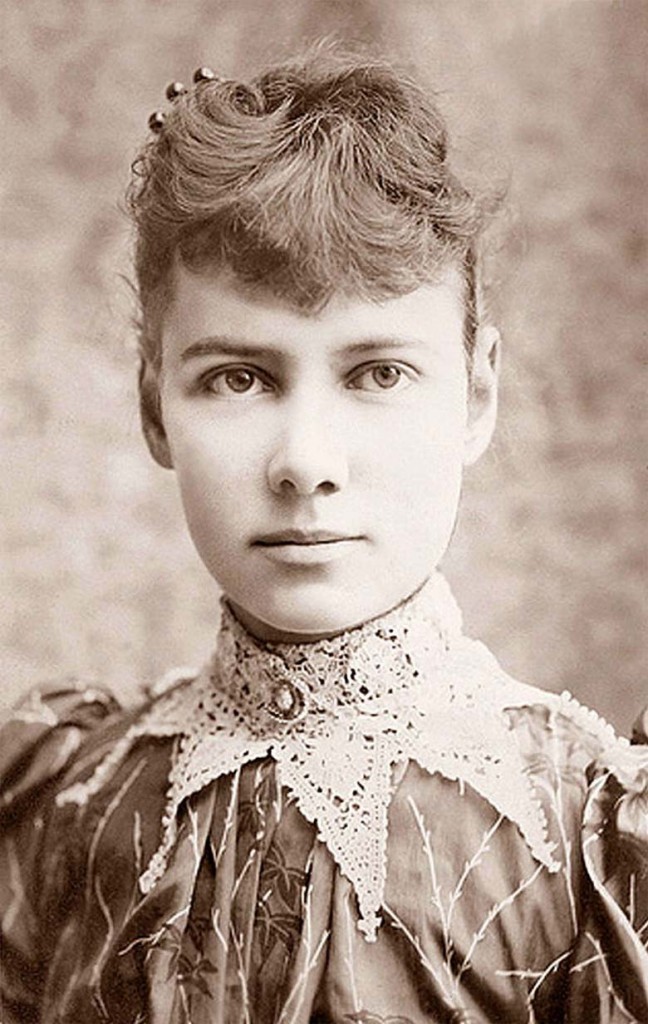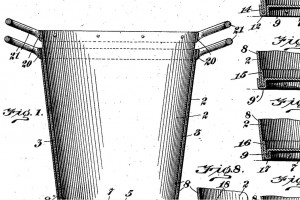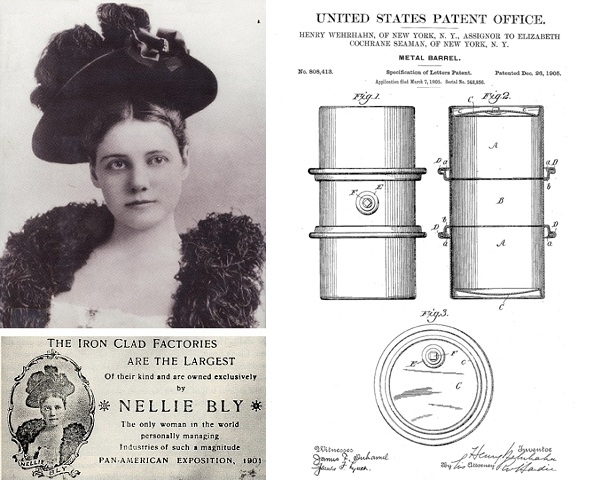She was among the most famous journalists of her day as a reporter for the New York World. Less known about Nellie Bly is her role in creating the 55-gallon steel oil drum.
The 55-gallon steel drum - used practically globally, for the creation of the musical instruments of the steelpan music family - was created by Ms. Bly's company - the Iron Clad Manufacturing Co. Although originally created for the storage of crude oil, the steel drums have been, and remain - the de facto raw material standard for the steelpan instrument.
The Remarkable Nellie Bly, Elizabeth J. Cochran Seaman (1867-1922)

After achieving fame as a journalist by age 25, “I determined to make steel containers for the American trade,” proclaimed Nellie Bly. January 1890 photo courtesy Library of Congress Prints and Photographs division.

Iron Clad Manufacturing Company President Elizabeth Cochrane Seaman received a 1902 patent for a stackable garbage can. She invented an improved milk can a year earlier.
The 1901 Pan-American Exposition in Buffalo, N.Y., promoted her Iron Clad Manufacturing Company as “owned exclusively by Nellie Bly – the only woman in the world personally managing industries of such magnitude.”
For her first assignment as a reporter for Joseph Pulitzer’s newspaper, the New York World, Elizabeth Jane Cochran – young Nellie Bly – feigned insanity for 10 days in New York’s notorious Blackwell’s Island Asylum. She had been hired in 1887 to write about the mental institution.
Writing under the pen name Nellie Bly (a character in a popular song of the time), her numerous exposés and adventures would capture the public’s imagination and make her a world famous woman journalist by age 25.
Much has been written about this remarkable woman from Cochran’s Mills, Pennsylvania, and her investigative reporting career with the Pittsburgh Dispatch and the New York World.
There is an equally fascinating side of her – the “Iron Clad” steel Nellie Bly oil drum.
In America’s oilfields, traditional wooden barrels had always been problematic for shipping oil. Despite the introduction of pipelines and railroad tank cars, there remained the need for manageable-sized, durable, leak-proof barrels.
Standard Oil Company introduced a steel version of the common 42-gallon oil drum in 1902. It had the traditional cask-like appearance. Although stronger than wooden barrels, the new barrel could still leak. Nellie Bly had a better idea.

Nellie Bly was assigned a 1905 patent for the “Metal Barrel” by its inventor, Henry Wehrhahn, who worked at her Iron Clad Manufacturing Company.
It was a big story for society pages in 1894 when Bly wed wealthy industrialist Robert Seaman, who was about 40 years her senior.
At the time, Iron Clad produced milk cans, riveted boilers, tanks, and “The Most Durable Enameled Kitchen Ware Made.”
At the 1901 Pan-American Exposition, Iron Clad factories were promoted as being, “Owned exclusively by Nellie Bly – the only woman in the world personally managing industries of such a magnitude.”

Nellie Bly brought energy and ideas to Iron Clad’s Brooklyn, New York, factory. The company had established itself as a kitchenware manufacture as shown in this 1884 advertisement.
Some questioned her management skills – but not her flamboyance – after her husband’s death in 1904, when she became the energetic and innovative president of his Iron Clad Manufacturing Company.
During a 1904 visit to Europe, Nellie Bly saw glycerin containers made of steel. “I determined to make steel containers for the American trade,” she said. She patented her own “metal barrel” one year later.
“My first experiment leaked and the second was defective because the solder gave way, and then I brazed them with the result that the liquid inside was ruined by the brazing metal,” she said.
“I finally worked out the steel package to perfection, patented the design, put it on the market and taught the American public to use the steel barrel,” she added.
Inventive Employee Henry Wehrhahn
Real credit must go to Nellie Bly’s employee, Henry Wehrhahn of Brooklyn, New York, who in December 1905 received two patents that would lead to the modern 55-gallon steel barrel.
“My invention has for its object to provide a metal barrel which shall be simple and strong in construction and effective and durable in operation,” Wehrhahn explained in his patent, no. 808,327, a flanged metal barrel. The familiar encircling hoops allowed for guided rolling of the barrel for better control.
A second patent issued at the same time provided “a means for readily detaching and securing the head of a metal barrel.”
Wehrhahn, who had entered the machinist trade in 1884 at age 18, became superintendent of the Iron Clad Manufacturing Company in 1902.
Wehrhahn assigned his inventions to his employer, Bly, who also patented a milk can and stacking garbage can. She proudly claimed that, “I am the only manufacturer in the country who can produce a certain type of steel barrel for which there is an immense demand at present, for the transportation of oil, gasoline, and other liquids.”
At its peak, Iron Clad employed 1,500 and could produce 1,000 steel barrels daily, but then charges of fraud led to bitterly contested bankruptcy proceedings, beginning in 1911. Nellie Bly was in Austria looking for financial backers when World War I began.
Wehrhahn earlier had moved on to become superintendent of Pressed Steel Tank Company of Milwaukee, Wisconsin, by 1912. Iron Clad Manufacturing Company eventually succumbed to debt, and Bly returned to newspaper reporting, covering women’s suffrage events and Europe’s Eastern Front during the war. Her steel barrels ultimately became the ubiquitous 55-gallon steel drums of today.
Elizabeth Jane Cochran Seaman died of pneumonia in 1922 – two years after the 19th Amendment secured her the right to vote. She was eulogized as Nellie Bly, “the best reporter in America,” by the New York Evening Journal.
She should also be remembered for her unique contribution to America’s petroleum history. Also see History of the 42-Gallon Oil Barrel.
Editor’s Note – In 1889, the New York World sent 25-year-old Bly on a steamboat trip around the world to mimic Phileas Fogg in Jules Verne’s Around the World in Eighty Days. After a 72-day journey of almost 25,000 miles, she returned to New York to write a widely popular book.

Replies
Birth of Pan III Spree Simon
This is another account of the Birth of Pan from representatives of Tokyo Steel Orchestra as it relates to the contribution of Winston "Spree" Simon who some refer to as the "Father of Pan".
Birth of the Steel Drum/Pan
Pan Pioneer Prince Batson describes the early history of the Steelband.
Calypso Showcase Birth of Pan
Because it have some dotish people - especially in North America - both T&T Expats and "colonists" of European descent - who doh know dey arse from dey elbow - and who say dat we instrument - dat de "Founding Fathers of Pan" in Trinidad call "pan" - is ah "steeldrum" - and dat ah "steelband" is ah "steeldrum band" and dat "pansticks" is "mallets" and dat" pantuner" is "steeldrum builder"..! Ah know ah go get thunder, an dey go want tuh kill de messenger because yuh eh like de message...!
George,
Doh say or tink dat. In every panyard I find myself in there was always a discussion to start about these very same tings you mention.. usually is "trini ppl" on d platform reminding everyone willing to listen that they should not get mixed up in what dem odder ppl want to change "we" name to.
Now that we have WST worldwide and informing of world events the young ones will eventually get the message. Doh let dem ppl take away we ting. Just continue to call the names we start with.
Bamboo = make loud sound.
Cover =(dustbin. Trash. garbage)= make a loud sound.
Biscuit tin = make a loud sound.
Pan= the new name to replace bamboo dustbin and biscuit tin.
Drum= make a loud sound.
Band= group of ppl making a collective sound using those sound makers.
THIS IS OUR HISTORY. WE EH WANT NOBODY CHANGING WE TING.
Thanks, Brenda. Ah hear yuh,
Ah find dis interview on Rudy "Twoleft" Smith Facebook page - is ah interview wit Oscar Pile bout how pan started
If yuh listen, yuh go notice he never once mention nutten bout "steeldrum".
https://www.youtube.com/watch?v=YwdVJ94IIwI&t=130s
Have a pleasant day an keep safe.
Oscar Pile - How Steelband Started
The impetus which led to the invention of the Steel Barrel was the oil boom in America 1850. because the wooden barrels developed leaks. I presented all these details at the 2015 ICP in Port of Spain illustrating why Anthony Williams and the early inventors should be nominated for the Nobel Prize in Physics for the unique invention and groundbreaking discovery from discarded waste materials for a sustainable future. BTW Nellie Bly could not even cast a vote at the time, women were not allowed
v
Thank you, Nellie Bly.
You gave T&T the vehicle that transformed the world of music and allowed our talent to blossom and prove what nobody thought was possible.
THANK YOU WHEN STEEL TALKS FOR KEEPING THE WORLD INFORMED ABOUT THE MAGIC OF 'PAN'
NOW! Who is going to take the next steps to invent the ideal sets of pans by size and metallurgy that will elevate 'PAN' to maturity as a family of instruments? Arthur DeCoteau [the legendary Arthur Bass] once said 'Pan will come of age when you could go to the music store and buy you C sharp note replacement. Calypso Guru Black Stalin also asked the question about continuous innovation in his winning song.
I HOPE THOSE DEVELOPMENTS TAKE PLACE IN TRINIDAD AND TOBAGO and not in some foreign university or pan factory.
-
1
-
2
of 2 Next